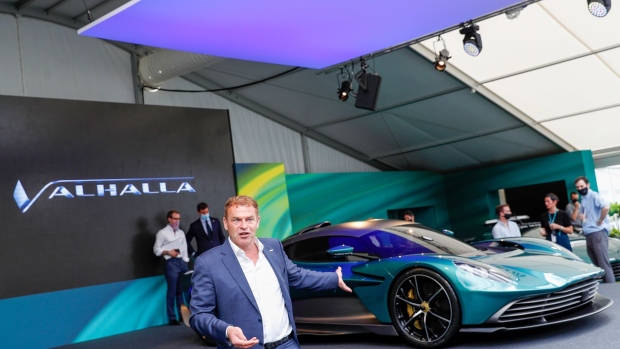Jan 20, 2022
Aston Martin Struggles to Keep Its Turnaround Momentum Going
, Bloomberg News

(Bloomberg) --
When Aston Martin prepared for its stock market debut in 2018, it sought to lure investors with scarcity value. There were few publicly traded luxury-car makers to invest in, and Aston at least stood a chance of replicating the success of Ferrari, whose value almost tripled in the three years after its 2015 initial public offering.
Things didn’t work out as advertised. Aston Martin shares have slid almost 90% since its London IPO as the company racked up significant losses and dealers were overloaded with inventory. It spent a good year restructuring itself after a rescue by Canadian billionaire Lawrence Stroll, who forged closer ties with Daimler’s Mercedes-Benz to ensure the carmaker synonymous with James Bond films survived the pandemic.
In mid-2020, the fashion mogul and die-hard motorsports fan hired a new CEO in Tobias Moers, who previously led Daimler’s Mercedes-AMG performance division. The hope was that the German manager, with his engineering background and track record of reviving the AMG brand, would usher in a new era of efficiency and margin growth and bring the company closer to the demand-driven model perfected by the likes of Porsche and Ferrari.
While Moers has made headway bolstering sales, his job is still proving to be an uphill battle. Aston Martin announced on Jan. 7 that fourth-quarter earnings would take a hit after it delivered fewer of its £2.4 million ($3.27 million) Valkyrie supercars than anticipated. While the company said the limited-edition model program is now back on track, my colleagues Siddharth Philip and Keith Naughton reported later that day that Stroll had approached a senior Ford executive to gauge his interest in replacing Moers.
The series of events underscore how hard it is for smaller, less-well capitalized carmakers to navigate the industry’s sweeping technology shifts — from the traditional dealership model to direct-to-consumer online sales, and from combustion engines to batteries.
Moers’s plan has been to expand Aston’s lineup with more iterations of the successful DBX sport utility vehicle, as well as revitalize its sports-car lineup. Another limited-edition model, the £700,000 Valhalla, is a plug-in hybrid with 937 horsepower and top speed of 217 miles per hour. The carmaker aims to offer either a hybrid or fully electric option of all its models by around 2025, and purely battery-powered cars will account for half of sales by the end of the decade.
But shifting toward batteries will require considerable resources, and that may prove challenging for a manufacturer that ended last year with just £420 million of cash on hand.
It’ll help that Aston will get an assist from Moers’s former employer in the years to come. After buying AMG engines for years, Aston is now also getting hybrid and electric powertrains from the Germans in return for shares, an arrangement that could boost Mercedes’ stake in the British company to as much as 20%.
Aston is far removed from the dire straights it was in when Stroll rescued it in early 2020. But if the Valkyrie issues linger and management turmoil persists, one has to wonder whether Mercedes will be cast as the Bond brand’s next savior.
©2022 Bloomberg L.P.





